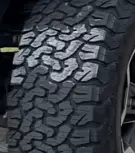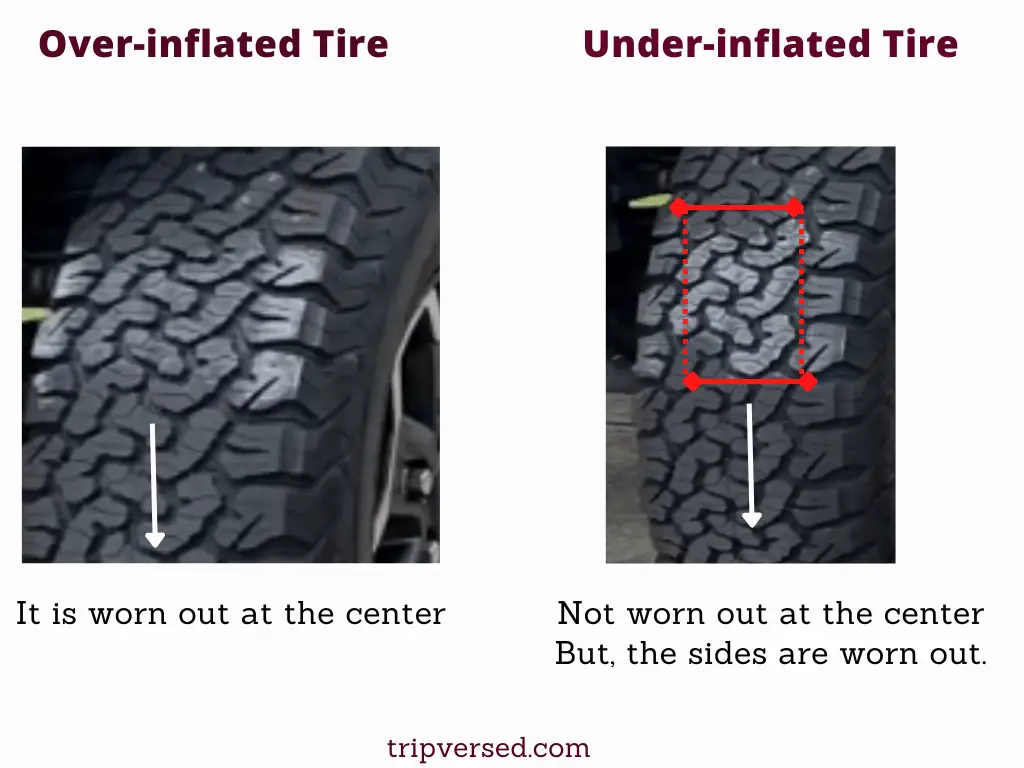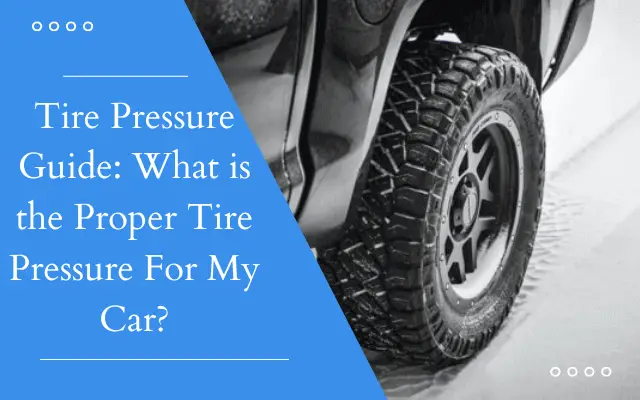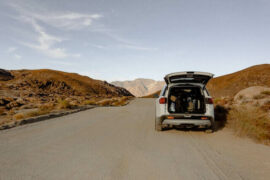Last Updated on January 30, 2023 by Rose Morah
In case you are wondering what the proper tire pressure for your car should be, you are in the right place.
Here is what we are going to cover in this article:
- The basic method of determining the proper tire pressure.
- How to determine the tire pressure when replacing your tires with aftermarket tires.
- When to ignore your vehicle’s recommended tire pressure.
- When to drive with under-inflated tires.
It is worth noting that driving with under or over-inflated tires could stabilize the vehicle and cause major safety issues.
It doesn’t matter where you are driving. Whether on the highway, on the beach, in the mud, on hills and rocks, on dirt roads e.t.c, having the right tire pressure is extremely important.
| Note: Some of the major highway accidents occur when the car pulls the driver out of their lane/road when driving at highway speeds with the wrong tire pressure. |
Effects of tire pressure
- Tire pressure affects fuel economy.
- Driving with incorrect tire pressure leads to premature tires wear.
- Inadequate tire pressure increases drag on the car. This is because it makes the vehicle engine and transmission work extra harder to keep the car moving.
- Proper tire pressure will save you both time and money.
| I would highly recommend you make it a habit to check your tires before you leave the house, and not only when going on road trips. |
Related:
What Causes Low Tire Pressure (And The Solutions).
How to Choose the Right Tire Size and Wheels (A Complete Guide).
How to determine the proper tire pressure
First of all, the amount of tire pressure that goes into the tire depends on your driving habits, which we are going to divide into two categories:
- Those who do regular short daily drives.
- Those who go on long road trips and drive off-road.
How to determine the proper tire pressure for people who do short daily drives
- STEP 1: Check the recommended maximum tire pressure on your tires.
You can do this by checking on the side of the tire.
You need not exceed the recommended max pressure.
- STEP 2: Find the vehicle’s recommended tire pressure.
You can find the vehicle’s manufacturer’s recommended tire pressure on the stickers that are on the side of the vehicle’s door frame/jamb.
If you do not see it, you can do a quick search on the manufacturer’s official website.
- STEP 3: Check your tire pressure to add or remove it based on the vehicle’s recommended tire pressure.
Here are two ways to correctly check the tire pressure:
- Using a tire gauge.
To get the right tire pressure using the tire gauge, ensure that the tires have cooled down.
This means if you are checking after driving the vehicle, you will need to let it cool down before you measure the tire pressure using the tire gauge for a more accurate reading.
Remember that after driving, the tires are usually heated up. The heat makes the tire pressure go up thus giving you inaccurate tire pressure readings.
The good this is that most tire gauges let you remove the air pressure from the tire if the tire is overinflated.
- Check on the dashboard
Fortunately, most modern vehicles have tire pressure monitors.
Most vehicles rely on the ABS system. Others have sensors in the tires to monitor when the tire pressure is under-inflated.
Vehicles such as Tesla will tell you what the tire pressure is and even the specific tire that has low pressure.
This is a great feature because most of the time the loss in tire pressure happens gradually without you noticing.
Related:
Best Tires For Electric Cars (Regular Tires VS. Special EV Tires).
4 Best Tesla Model 3 Tires (According to Model 3 Owners).
| Note: I have heard people complain that sometimes the tire pressure monitor of their cars does not work properly. In most cases, the battery of the tire sensors may have died, therefore, giving you inaccurate results. Most tire sensory batteries have a lifespan of 8 years. If you suspect that yours is not working properly, take it for inspection. |
How to determine proper tire pressure for people who go on long road trips and drive off-road
There are so many variables that will help determine the proper tire pressure for your vehicle.
However, the most important variable is the vehicle’s load.
You need to consider load in two ways:
- Passengers’ load and other items that you will be carrying in your vehicle.
This means that, if you will be carrying more passengers and tools or luggage in your vehicle, then you will need to increase your tire pressure to compensate for the extra weight.
- If you enjoy driving at high speeds and like to experience long-distance driving on different roads and routes, car racing, and dirt driving, this is also a type of load on the tires due to the experience.
Lots of cornering, braking, and acceleration puts more load onto the tires than you may actually think.
So, what’s the right tire pressure in such drivers?
There’s no one-thumb rule on the right tire pressure for these kinds of drives.
This is because the amount of tire pressure will depend on the amount of load on the vehicle and how challenging the terrain is.
The only way that you can determine whether your tires are properly inflated or not is through the following tire wear method:
- Use your eyes to check for even and uneven tire wear.
You can do this by looking at the tires closely to see if they are evenly or unevenly worn out.
- Use a tire measure tool to check for uneven tire wear.
You can use the tire depth measure tool, like the one below, to measure the difference between different parts of the tire (left, right, and center). Then compare to know the most worn parts.

See also:
28 Best and Must-have Road Trip Car Accessories.
6 Must-Have EV Accessories (Best EV Accessories).
What does the tire wear tell you about the tire pressure?
If you see more uneven tire wear at the center of the tire, in most cases, this is a sign of over-inflated tires.
You hence need to reduce the tire pressure.
On the other hand, if you notice that the wear is more on the edge than on the center of the tire, this is a sign of under-inflated tires.
You need to pump more air into the tire.
| NOTE: There are instances when you need to pump more tire pressure that exceeds the vehicle’s recommendation. In such situations, I suggest you refer to the max tire pressure that is indicated on the side of the tire. Don’t pump above the max pressure. This way, it will be safe because the tire pressure does not exceed the recommended limit. Additionally, this means that you have tweaked your tire pressure based on the load and the vehicle’s dynamic performance. |
You may also like List Of The Best All-Season Performance Tires.
When to ignore the vehicle’s recommended tire pressure
In most cases, you should ignore the recommended vehicle’s manufacturer’s tire pressure when you put aftermarket tires on your heavy-duty truck.
Additionally, I’d recommend you use a loading inflation table to show you what tire pressure you should be driving on per weight per tire.
For instance, in order to determine the right pressure for each tire on your truck, weigh the track on the scale.
It needs to be weighed when loaded and also when unloaded.
Then use the inflation table to calculate the amount of tire pressure needed on the tires.
What if you do not have access to a weighing scale?
Well, you will need to get an air compressor, tire pressure gauge, and a piece of chalk.
Follow the following steps once you have the three items:
- Step 1: Inflate the tires.
When starting out I recommend filling the tires with more pressure or exactly what the vehicle’s tire pressure sticker recommends.
For example, I start with 50 PSI front tires and 55 PSI on the rear truck tires even though the sticker recommends up to 65 PSI and 80 PSI respectively. This is because I know 65 PSI will be too much pressure.
Another example; is on our Jeep Gladiator, the manufacturer’s tire recommendation is 37 PSI, so I start from the 37 PSI on all tires.
| TIP When inflating, it is a lot easier and time-saving to start off with high tire pressure, then reduce it to the correct tire pressure. This is normally much easier than starting off at lower pressure and then adding it to the correct amount. |
- Step 2: Use your chalk to draw across the tire.
Draw the chalk on both the front and rear tires of the truck, as shown below.

- Step 3: Do a linear drive for about 100 meters.
I would suggest driving on paved roads and avoiding very dirty off-roads for clear results.
No need to go far, just a short distance then stop to check how the chalk is wearing out.
- Step 4: Stop and inspect the tire.
If you notice the chalk wearing out more on the edges of the truck tires, you need to add more pressure onto the tires. This means they are under-inflated.
On the other hand, if the chalk is wearing out more at the center than on the edges, you will need to drop the pressure. This means they are over-inflated.

Note: You may need to repeat this method many times until you get the right tire pressure for your truck.
What indicates the right truck tire pressure?
Trucks are different. Therefore, the expected tire pressure for each truck will vary.
However, one thing that is common with truck tires is, don’t expect to get perfect even tire wear because truck tires are not designed for that.
Therefore, when using this method, you should aim for close to perfect even tire wear.
This means that there’s slightly more ground contact in the center and the edges are not quite touching.
| NOTE: Based on the above chalk method, sometimes you will find that the proper tire pressure of your aftermarket tires is below the vehicle’s recommended factory threshold, mostly when the truck is not loaded. This is okay on most trucks with aftermarket tires. However, this could be a problem for those with newer trucks like FORD and RAM. This is because the vehicle will consistently send you warning lights due to improper tire pressure. However, there are different ways to fix this issue. For example, for FORD you can change the tire threshold through a program called FORScan |
Are there downsides to achieving the right tire pressure?
Yes. As much as the right tire pressure promotes comfort and safety when driving, this will also come with decreased fuel economy.
According to tire experts, when a vehicle is over-inflated, this is good for fuel economy and vice versa.
Therefore, what this means is that you have to choose between comfort and safety vs fuel economy.
However, sometimes the decreased fuel economy can go unnoticed.
See also: Smart Ways To Conserve Gas When Running Low.
When is low tire pressure highly recommended when driving?
Low tire pressure is highly recommended when driving off-road because it increases the vehicle’s off-road abilities.
| Lower tire pressure on 4WD = an increased footprint. |
The table below shows a rough recommendation of the 4WD tire pressures when you are driving on different terrains, according to the 4WD tire pressure glove box guide.
| Type of Terrain | Tire Pressure | |
| 1. | Sand | 16 PSI |
| 2. | Rock | 20 – 22 PSI |
| 3. | Mud | 20 – 22 PSI |
| 4. | Touring (Dirt ride) | 28 PSI |
The following table shows the effect of the tire pressure on your 4WD when driving on sand.
| PSI | Footprint size | Performance on the soft sand (beach) |
| 36 PSI | 500mm | Barely goes any far. Less than 50m distance, then the vehicle gets stuck. |
| 28 PSI | 520mm | Not any different from the 36 PSI. |
| 16 PSI | 545mm | There’s a massive difference when driving on the same sand. The vehicle moves without getting stuck in the sand. |
When driving under hot temperature conditions, the tire pressure may increase throughout the day.
Therefore, you’ve got to keep checking it during the day.
Additionally, your 4WD tire pressure will highly depend on the following factors when driving off-road:
- How heavy the vehicle is.
- How loaded the vehicle is.
- How fast you will be going.
- How tough the terrain is.
Note that, once you are done with your off-road driving and ready to hit the highway/tarmac you will need to pump the tires back up.




